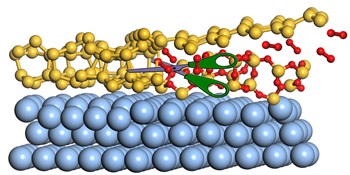| Peeling off the layers for new electronics |
| From: PublishDate:2017-06-16 Hits: |
Much like an overcooked dinner, the next so-called wonder material for next-generation electronics has been ‘stuck to the pan’ until researchers from Institute for Superconducting and Electronic Materials (ISEM) at the University of Wollongong (Australia), Dalian University of Technology, and the Beijing Synchrotron Radiation Facility (Chinese Academy of Sciences) came up with a breakthrough solution. The material is silicene, the thinnest possible form of silicon, comprised of a two-dimensional layer of silicon crystals. Electrons move ultrafast in silicene, reducing the energy required to drive electronic devices and paving the way for even smaller, flexible, transparent and low-energy-cost electronics.
Until now, silicene has been ‘grown’ on a metal surface, but researchers had no proven way of freeing it from the substrate to create a freestanding material that could then be incorporated into electronic devices and components. ISEM Senior Research Fellow Dr Yi Du and his team have used oxygen to separate a single-atom thick layer of silicon from its surface, overcoming the key hurdle preventing the production of a material with potential to supercharge electronics.“We know silicene crystals prefer to firmly attach on the metallic substrate and because they are too thin to be peeled off by any mechanical tools, it’s impossible to remove them from the substrate,” Dr Du said. Researchers have experimented with the idea of using ‘chemical scissors’ to break the bond between silicene and the substrate and the breakthrough for Dr Du and his team came through using oxygen molecules as chemical scissors to cut the silicene from its substrate. The chemical dynamics process has been clearly revealed through a theoretical simulation by Professor Jijun Zhao from the Dalian University of Technology. Dr Jiaou Wang at the Beijing Synchrotron Radiation Facility (Chinese Academy of Sciences) has proven that the freestanding silicene remain its Dirac fermion characteristics, which is of great importance in future applications.
Freestanding silicene is emerging player in the super-materials category, alongside graphene, which is a single-atom thick layer of carbon. This work makes it unsuitable for applications such as transistors. Because silicon and carbon sit side-by-side on the periodic table, scientists were inspired to investigate if silicon’s atomic properties could be similarly revolutionary but more easily exploited because of its compatibility with existing silicon-based electronics.
The research was published recently in the journal Science Advances and is the result of collaboration between Australian and Chinese researchers including Professor Jijun Zhao, from the Dalian University of Technology and Dr Jiaou Wang at the Beijing Synchrotron Radiation Facility (Chinese Academy of Sciences) . This research was supported by Australian Research Council and National Natural Science Foundation of China. Article:Quasi-freestanding epitaxial silicene on Ag(111) by oxygen intercalation. Science Advances, 2016, 2, e1600067. |
|
|
| Chinese
- Metal-free efficient photocatalyst for stable visible water splitting——Top ten major scientific progresses in China in 2015
- The nano-resolution imaging platform was awarded the first rate prize of Beijing Science and Technology in 2014
- Beamline 1W1 of BSRF started to runoperate in the couplingparasitic mode of BEPCII
- Synthesis of High Performance Polymer Materials for Field Effect-Transistors
- Surfactant molecular aggregates in green solvents
- GIXRD has played an important role in the characterization of organic thin-film transistors
Copyright © 2011 - 2012 Beijing Synchrotron Radiation Facility


